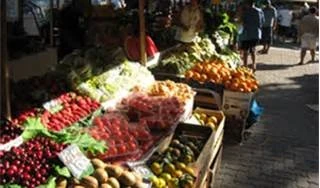
The Fruit Stand
The Fruit Stand is a place for street commerce where people sell food like fruits and vegetables and sometimes other things.
A fruit stand is a primarily open-air business venue that sells seasonal fruit and many fruit products from local growers. It might also sell vegetables and various processed items derived from fruit. The fruit stand is a small business structure that is primarily run as an independent sole proprietorship, with very few franchises or branches of larger fruit stand conglomerates, though many large food industry businesses have developed from fruit stand businesses.
The fruit stand has been a neighborhood hub for many generations and is one of the few enterprises that is important to every culture and readily available on every continent. Fruit stands still comprise a primary distribution system for the fresh produce consumed by millions in developing countries.
In the movies
Rio
A fruit stand was featured in the first film, it was located in Rio de Janeiro. When Blu and Jewel come with Rafael to find Luiz, they are introduced to Nico and Pedro. They dissapointingly have to catch the next ride to Luiz. They then head off to the Samba Club around that area. They also fight Mauro and the marmosets there. Then they get a lift by Kipo.
There is also a deleted scene from the movie that takes place in the fruit stand, with Jewel coaxing Blu into trying some of the fruit there, causing him to go on a massive eating spree, being encouraged by Jewel and Rafael to try the different fruits native to Brazil being sold there.
Rio 2
In the second film, in Manaus, there is a fruit stand where Nigel is kept as a performer for profit, along with Gabi who is trapped in a glass container, and Charlie as a entertaining and dancing anteater. The stand is full of a variety of items from fruits, to hand made baskets, dyes and exotic animals for exposition.
History
In the most traditional food distribution model, farmers and growers sell foodstuffs directly to consumers. A simple stand located adjacent to an established road/transportation route is the most familiar model. Fruit and produce stands are often seasonal, harvest-based operations. In the U.S., some fruit stands have grown into famous grocery store chains. Started as a fruit stand in 1948, the Dorothy Lane Market (DLM) company is now a chain of specialty grocery stores.[1] Sprouts, LLC, with over $2.5 million in actual sales in 2013,[2] claims to share a similar history.
According to the History Channel, Dole Foods began as a roadside pineapple stand in Hawaii.[3] In 2010, the food industry conglomerate had revenues of over $6.9 billion from operations in more than 90 companies.[4]
The past half-century has seen increasing agricultural mechanization, genome-based crop yield modifications, widespread chemical pesticide use, markets influences by subsidies and tariffs and increased household spending capacity. Agribusiness has been the natural business model in this context.
Many but not all people now have a broader range of produce and other foods to choose from in their grocery stores, often at a lower cost.
Trivia
- There is a deleted scene where Jewel tries to get Blu to eat from the fruit stand.
- When he finds out it's so good he says "it's a fiesta on my tounge."
- He also swallows a whole watermelon.
- Nico's, Pedro's, and Kipo's samba club also takes place here.
- This is where the birds and marmosets also fight.
- An Angry Birds episode, now called Market Mayhem was originnally called "Fruit Market".
- This could be where the fruit stand is at in the game.
Gallery
- Main article: Fruit Stand/Gallery
